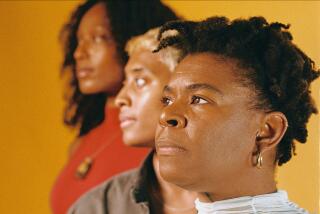A Haven for Deaf Gays, Lesbians : A group, an outgrowth of informal Valley gatherings, has helped forge an outlet for what some would call a double minority.
- Share via
When Linda Cummings came to terms with her lesbian orientation in her 20s, she found little support. It was hard enough to seek out other lesbians in the 1960s, she says, but being deaf made the process twice as difficult.
“At the time, I found a role model who was with her lover for 40 years,” says Cummings, 50, a Van Nuys resident who lives with Susan Snapp, her hearing partner of five years, who translates for her. “She said she was jealous of me because I was born in a more tolerant time. That’s what I tell other lesbians today.”
Cummings has played a role in creating that tolerance. A founding member of the Southern California Rainbow Society of the Deaf, she has helped build a haven for what some would call a double minority. An outgrowth of informal gatherings in San Fernando Valley homes in the early 1970s, the society has gone on to hold educational workshops on leadership, civil rights, and deaf gay and lesbian culture.
Most prominent among the society’s programs, however, are social events, which include pool parties, picnics, holiday gatherings, camping trips and sign-language-interpreted theater performances. “We have more parties than workshops,” says Cummings, an advisory board member of Hollywood-based AIDS Education Services for the Deaf, which coordinates with SCRSD to increase AIDS awareness. “There are few outlets where deaf gays and lesbians can meet, make friends or date, so Rainbow has become an important networking group.”
Most of SCRSD’s 500 members are Valley residents, due to the drawing power of Cal State Northridge’s deaf studies department and the North Hollywood office of the Greater Los Angeles Council on Deafness. SCRSD events are usually held in the Valley.
The organization also holds a biannual conference in conjunction with its parent organization, the Rainbow Alliance of the Deaf, based in Florida. RAD was founded in 1977, a year after SCRSD, but took the leadership role and has formed 24 chapters, with a membership of 5,000 across the United States and Canada. SCRSD is RAD’s largest chapter.
RAD’s most recent conference was held in Universal City in June. It offered workshops on personal finance, AIDS awareness and, of course, eight parties in six days, culminating with West Hollywood’s gay and lesbian pride parade and festival.
“It can be lonely when you go to bars and find you’re the only deaf lesbian there,” said Cathy, 40, a Valley member who declined to reveal her last name. Cathy says she had the ideal environment in which to accept her sexuality--earning her sociology degree at Gallaudet University for the deaf in Washington. “I was able to identify with other lesbians and gays on campus, so I didn’t feel so isolated. Once I was out in the ‘real world,’ it really took time to build friendships and just find people to hang around with. That’s why SCRSD is so ideal.”
On her need to remain anonymous, she adds: “I’m an open lesbian in the deaf community and I’m well-respected, but in the hearing community, I’m just not comfortable with being out at work.”
Other SCRSD members concur that they find ready acceptance among the deaf community’s straight members, but prefer to be less visible in the hearing world.
“The hearing community is a larger place, so there’s more chance for discrimination,” SCRSD President Gregg Brooks says. “But our own deaf circles are small. We can’t afford to reject one another because we need each other for our skills and knowledge. The deaf community is much more receptive to differences. That’s how we learned to survive in the first place--by accepting our own differences.”
Brooks adds that some deaf gays and lesbians shun SCRSD and RAD, fearing stigma. “But SCRSD is a place to feel comfortable, share information and realize you’re not alone. Growing up both deaf and gay can be doubly isolating,” the Los Angeles resident says.
Brooks, born deaf, says he came to terms with his sexuality “very, very slowly” and had not fully accepted it until he turned 45. Now 53, he met Ken, his partner of eight years, through SCRSD.
“SCRSD feels like family,” says Brooks, who is also president of the Greater Los Angeles Council on Deafness. “People sometimes think being gay and deaf is a double handicap, but I consider it a double pleasure. I’m very happy to be both.”
The organization meets quarterly at the Gay and Lesbian Community Services Center, 1625 N. Hudson Ave., Hollywood. The next meeting is at 10 a.m. Oct. 16.
Where and When What: Southern California Rainbow Society of the Deaf annual summer picnic. Location: North Hollywood Park, Lot 5. Mail: SCRSD, P.O. Box 2686, Van Nuys 91404. Hours: 11 a.m.-dusk Saturday. Price: $10. Call: California Relay Service (800) 735-2922, which translates calls through Telecommunications Device for the Deaf. Ask for (213) 669-1949.
More to Read
Sign up for Essential California
The most important California stories and recommendations in your inbox every morning.
You may occasionally receive promotional content from the Los Angeles Times.













